The Red Fox (Vulpes vulpes) is the largest of the true foxes, as well as being the most geographically spread member of the Carnivora, being distributed across the entire northern hemisphere from the Arctic Circle to North Africa, Central America, and the steppes of Asia. Its range has increased alongside human expansion, having been introduced to Australasia, where it is considered harmful to native mammal and bird populations. Because of these factors, it is listed as Least Concern for extinction by the IUCN.
The red fox originated from smaller-sized ancestors from Eurasia during the Middle Villafranchian period, and colonised North America shortly after the Wisconsian glaciation. Among the true foxes, the red fox represents a more progressive form in the direction of carnivory. Apart from its large size, the red fox is distinguished from other fox species by its ability to adapt quickly to new environments and, unlike most of its cousins, is not listed as endangered anywhere. Despite its name, the species often produces individuals with abnormal colourings, including albinos and melanists. 45 subspecies are currently recognised, which are divided into two categories ; the large northern foxes, and the small, primitive southern foxes of Asia and the Middle East.
Red foxes are social animals, whose groups are lead by a mated pair which monopolises breeding. Subordinates within a group are typically the young of the mated pair, who remain with their parents to assist in caring for new kits. The species primarily feeds on small rodents, though it may also target leporids, game birds, reptiles, invertebrates and young ungulates. Fruit and vegetable matter is also eaten on occasion. Although the red fox tends to displace or even kill its smaller cousins, it is nonetheless vulnerable to attack from larger predators such as wolves, coyotes, golden jackals and large felines.
The species has a long history of association with humans, having been extensively hunted as a pest and furbearer for centuries, as well as being prominently represented in human folklore and mythology. Because of its widespread distribution and large population, the red fox is one of the most important furbearing animals harvested for the fur trade.
Evolution
The red fox is considered a more specialised, progressive form of Vulpes than the Afghan, corsac and Bengal fox in the direction of size and adaptation to carnivory ; the skull displays much fewer neonatal traits than in other species, and its facial area is more developed. It is, however, not as maximally adapted for a carnivorous diet as the Tibetan fox is.
Origins
The species is Eurasian in origin, and probably evolved from either Vulpes alopecoides or the related Chinese V. chikushanensis, both of which lived during the Middle Villafranchian. The ancestral species was likely smaller than the current one, as the earliest red fox fossils are smaller than modern populations. The earliest fossil remains of the modern species date back to the mid-Pleistocene in association with the refuse of early human settlements. This has led to the theory that the red fox was exploited by primitive humans as both a source of food and pelts.
Colonisation of North America
Red foxes migrated relatively late into the North American continent, sometime after the Wisconsian glaciation. There are seemingly no records of the species' presence in North America antedating the Sangamonian, with the possible exception of the far north, where red fox fossils have been found in Sangamonian deposits in the Fairbanks District and Medicine Hat. Fossils dating from the Wisconsian are present in 25 sites in Arkansas, California, Colorado, Idaho, Missouri, New Mexico, Tennessee, Texas, Virginia and Wyoming. Although they ranged far south during the Wisconsian, the onset of warm conditions shrank their range toward the north, and have only recently reclaimed their former American ranges thanks to human induced environmental changes. Genetic testing indicates that there are two distinct red fox refugiums in North America, which have been separated since the Wisconsian. The northern (or boreal) refugium occurs in Alaska and western Canada, and consists of the large subspecies alascensis, abietorum, regalis and rubricosa. The southern (or montane) refugium occurs in the Rocky Mountain's subalpine parklands and alpine meadows, the Cascade Range and Sierra Nevada. It encompasses the subspecies macroura, cascadensis and necator. The latter clade has been separated from all other red fox populations since the last glacial maximum, and may possess unique ecological or physiological adaptations.Subspecies
As of 2005[update], 45 subspecies are recognised. However, substantial gene pool mixing between different subspecies is known; British red foxes have crossbred extensively with foxes imported from Germany, France, Belgium, Sardinia, and possibly Siberia and Scandinavia. European foxes were introduced to portions of the USA in the 18th century, thus crossbreeding with local North American populations. Also, introduced eastern red foxes in California may be interbreeding with local V. vulpes necator populations. Red fox subspecies are divided into two categories:
- Northern foxes: Large, brightly colored foxes.
- Southern grey desert foxes: Includes the Asian subspecies griffithi, pusilla and flavescens. These foxes display transitional features from northern red foxes to smaller species ; their skulls possess more primitive, neonatal traits than the northern forms. They are also much smaller than the northern forms ; the maximum sizes attained by southern foxes are invariably less than the average sizes of northern foxes. Their limbs are also longer, and their ears larger.
Red foxes living in Middle Asia show physical traits intermediate to the northern and southern forms
Subspecies | Trinomial authority | Description | Range | Synonyms |
|---|---|---|---|---|
| Middle Russian fox Vulpes v. vulpes | Linnaeus, 1758 | A large subspecies measuring 70–90 cm in length and weighing 5–10 kg. The maximum length of the skull for males is 163.2 mm. The fur is bright red with a strongly developed whitish and yellow ripple on the lower back. | Northern and middle (forest) districts of the European part of the former Soviet Union, southwards to forest-steppe and eastwards approximately to the Urals. Also occurs in Scandinavia and probably Central and Western Europe | alopex (Linnaeus, 1758) communis (Burnett, 1829) |
| British Columbian fox Vulpes v. abietorum | Merriam, 1900 | Generally similar to V. vulpes alascensis, but with a lighter, longer and more slender skull | Interior of British Columbia and probably southeastern Alaska, USA | sitkaensis (Brass, 1911) |
| Northern Alaskan fox Vulpes v. alascensis | Merriam, 1900 | A large, long tailed, small eared form with golden-fulvous fur. | Andreafsky Wilderness, Alaska, USA | |
| Eastern Trans-Caucasian fox Vulpes v. alpherakyi | Satunin, 1906 | A small subspecies weighing 4 kg, with a maximum skull length of 132–39 mm in males and 121–26 mm in females. The fur is rusty grey or rusty brown with a brighter rusty stripe along the spine. The coat is short, coarse and sparse | Geok Tepe, Aralsk, Kazakhstan | |
| Anatolian fox Vulpes v. anatolica | Thomas, 1920 | Smyrna, western Asia Minor, Turkey | ||
| Arabian fox Vulpes v. arabica | Thomas, 1920 | Muscat, Oman | ||
| Atlas fox Vulpes v. atlantica | Wagner, 1841 | Atlas Mountains, Mila Province, Algeria | algeriensis (Loche, 1858) | |
| Labrador fox Vulpes v. bangsi | Merriam, 1900 | Similar to V. vulpes fulva, but with smaller ears and less pronounced black markings on the ears and legs | L'Anse au Loup, Strait of Belle Isle, Labrador, Canada | |
| Barbary fox Vulpes v. barbara | Shaw, 1800 | Barbary Coast, north-western Africa | acaab (Cabrera, 1916) | |
| Anadyr fox Vulpes v. beringiana | Middendorff, 1875 | A large subspecies. It is the most brightly coloured of Old World red foxes, the fur being saturated bright-reddish and almost lacking the bright ripple along the back and flanks. The coat is fluffy and soft. | Shore of the Bering Strait, north-eastern Siberia | anadyrensis (J. A. Allen, 1903) beringensis (Merriam, 1902) |
| Cascade Mountain fox Vulpes v. cascadensis | Merriam, 1900 | A short tailed, small toothed fox with yellow rather than fulvous fur. It is the commonest form producing "cross" varieties | Cascade Mountains, Skamania County, Washington, USA | |
| North Caucasian fox Vulpes v. caucasica | Dinnik, 1914 | A large subspecies with a variable color ranging from reddish to red-grey and nearly grey. The fur is short and coarse. This form could be a hybrid of mixing V. vulpes stepensis and V. vulpes karagan populations | Near Vladikavkaz, Caucasus, Russia | |
| European fox Vulpes v. crucigera | Bechstein, 1789 | A medium sized subspecies, with a yellowish-fulvous or reddish-brown pelt lacking the whitish shading on the upper back. The tail is not grey, as in most other subspecies. It is primarily distinguished from V. vulpes vulpes by its slightly smaller size, distinctly smaller teeth and widely spaced premolars. Red foxes present in Britain (and therefore Australia) are usually ascribed to this subspecies, though many populations there display a great degree of tooth compaction not present in continental European populations | All Europe, except Scandinavia, Spain and some islands of the Mediterranean Sea. Introduced to Australia and Virginia | alba (Borkhausen, 1797) cinera (Bechstein, 1801) |
| Trans-Baikal fox Vulpes v. daurica | Ognev, 1931 | A large subspecies. The color along the spine is light, dull yellowish-reddish with a strongly developed white ripple and greyish longitudinal stripes on the anterior side of the limbs. The coat is coarse but fluffy | Kharangoi, 45 km west of Troizkosavsk, Siberia | ussuriensis (Dybowski, 1922) |
| Newfoundland fox Vulpes v. deletrix | Bangs, 1898 | A very pale colored form, with light, straw yellow fur deepening to golden yellow or buff-fulvous in some places. The tail lacks the usual black basal spot. The hind feet and claws are very large | Bay of St. George, Newfoundland, Canada | |
| Ussuri fox Vulpes v. dolichocrania | Ognev, 1926 | Sidemi, southern Ussuri, south-eastern Siberia | ognevi (Yudin, 1986) | |
| Vulpes v. dorsalis | J. E. Gray, 1838 | |||
| Turkmenian fox Vulpes v. flavescens | J. E. Gray, 1838 | A small subspecies, with an infantile skull and an overall grey colored coat. Body length is 49-57.5 cm, and weighs 2.2-3.2 kg | Northern Iran | cinerascens (Birula, 1913) splendens (Thomas, 1902) |
| Virginia fox Vulpes v. fulvus | Desmarest, 1820 | A smaller subspecies than V. vulpes vulpes, with a smaller, sharper face, a shorter tail and a lighter pelt more profusely mixed with whitish, and darker limbs | Virginia, USA | pennsylvanicus (Rhoads, 1894) |
| Afghan red fox Vulpes v. griffithi | Blyth, 1854 | Slightly smaller than V. vulpes montana, with a more extensively hoary and silvered pelt | Kandahar, Afghanistan | flavescens (Hutton, 1845) |
| Kodiak fox Vulpes v. harrimani | Merriam, 1900 | A large subspecies with an enormous tail and coarse, wolf-like fur on the tail and lower back. The hairs on the neck and shoulders are greatly elongated and form a ruff | Kodiak Island, Alaska, USA | |
| Southern Chinese fox Vulpes v. hoole | Swinhoe, 1870 | Near Amoy, Fukien, southern China | aurantioluteus (Matschie, 1907) lineiventer (Swinhoe, 1871) | |
| Sardinian fox Vulpes v. ichnusae | Miller, 1907 | A small subspecies with proportionately small ears | Sarrabus, Sardinia, Italy. May have been introduced to the English Midlands | |
| Cyprus fox Vulpes v. indutus | Miller, 1907 | Cape Pyla, Cyprus | ||
| Yakutsk fox Vulpes v. jakutensis | Ognev, 1923 | Large, but smaller subspecies than V. vulpes beringiana. The back, neck and shoulders are brownish rusty, while the flanks are bright ocherous reddish-yellow | Taiga, south of Yakutsk, eastern Siberia | sibiricus (Dybowski, 1922) |
| Japanese fox | Ognev, 1923 | Japan | ||
| Karaganka fox Vulpes v. karagan | Erxleben, 1777 | A smaller subspecies than V. vulpes vulpes. The fur is short, coarse and is of a light sandy-yellow or yellowish grey colour | Kirghiz Steppes, Khirgizia, Russia | ferganensis (Ognev, 1926) melanotus (Pallas, 1811) |
| Kenai Peninsula fox Vulpes v. kenaiensis | Merriam, 1900 | One of the largest North American subspecies, with softer fur than V. vulpes harrimani | Kenai Peninsula, Alaska, USA | |
| Trans-Caucasian montane fox Vulpes v. kurdistanica | Satunin, 1906 | A form intermediate in size between V. vulpes alpheryaki and V. vulpes caucasica. Its fur is pale yellow or light grey, sometimes brownish-reddish and is fluffier and denser than that of other Caucasian subspecies | Gelsk Valley, north-eastern Turkey | alticola (Ognev, 1926) |
| Wasatch Mountain fox Vulpes v. macroura | Baird, 1852 | Similar to V. vulpes fulva, but with much longer tail, larger hind feet and has more extensive blackening of the limbs | Wasatch Mountains, near Great Salt Lake, Utah, USA | |
| Hill fox Vulpes v. montana | Pearson, 1836 | Distinguished from V. vulpes vulpes by its smaller size, proportionately smaller skull and teeth and coarser fur. The hairs on the sole of the foot are copiously mixed with softer woolly hairs. | Himalaya | alopex (Blanford, 1888) himalaicus (Ogilby, 1837) |
| High Sierra fox Vulpes v. necator | Merriam, 1900 | Externally similar to V. vulpes fulvus (having a short tail), but cranially more like V. vulpes macroura | High Sierra, California | |
| Nile fox Vulpes v. niloticus | E. Geoffroy Saint-Hilaire, 1803 | A small subspecies measuring 76.7-105.3 cm in body length, 30.2-40.1 cm in tail length and weighing 1.8-3.8 kg. It is ruddy to grey-brown above and darker on the back of the neck. The flanks are greyer and tinged with buff. | Egypt | aegyptiacus (Sonnini, 1816) anubis (Hemprich and Ehrenberg, 1833) |
| Turkestan fox Vulpes v. ochroxantha | Ognev, 1926 | Aksai, Semirechye, eastern Russian Turkestan, Kirgizia | ||
| Palestinian fox Vulpes v. palaestina | Thomas, 1920 | Ramleh, near Jaffa, Occupied Palestinian Territory | ||
| Korean fox Vulpes v. peculiosa | Kishida, 1924 | Korea | kiyomassai (Kishida and Mori, 1929) | |
| White footed fox Vulpes v. pusilla | Blyth, 1854 | Slightly smaller than V. vulpes griffithii. Closely resembles V. bengalensis in size, but is distinguished by its longer tail and hind feet. | Salt Range, Punjab, Pakistan | leucopus (Blyth, 1854) persicus (Blanford, 1875) |
| Northern Plains fox Vulpes v. regalis | Merriam, 1900 | The largest North American red fox species, with very large and broad ears and a very long tail. It is of a golden yellow colour with pure black feet | Elk River, Sherburne County, Minnesota, USA | |
| Novia Scotia fox Vulpes v. rubricosa | Bangs, 1898 | A large sized subspecies with a large, broad tail and larger teeth and rostrum than V. vulpes fulva. It is the deepest coloured form | Digby, Nova Scotia, Canada | bangsi (Merriam, 1900) deletrix (Bangs, 1898) |
| Sakhalin fox Vulpes v. schrencki | Kishida, 1924 | Sakhalin, Russia | ||
| Spanish fox Vulpes v. silacea | Miller, 1907 | Near Silos, Burgos, Spain | ||
| Kurile Island fox Vulpes v. splendidissima | Kishida, 1924 | North and central Kurile Islands, Russia | ||
| Steppe fox Vulpes v. stepensis | Brauner, 1914 | A slightly smaller and more lightly coloured subspecies than V. vulpes crucigera, with shorter, coarser fur. Specimens from the Crimean mountains have brighter, fluffier and denser fur | Steppes near Kherson, Russia | krymeamontana (Brauner, 1914) crymensis (Brauner, 1914) |
| Tobol'sk fox Vulpes v. tobolica | Ognev, 1926 | A large subspecies with yellowish rusty or dirty reddish fur with a well developed cross, and often black area on the belly. The coat is long and fluffy | Obdorsk, Tobolsk, Russia | |
| Northern Chinese fox Vulpes v. tschiliensis | Matschie, 1907 | Slightly larger V. vulpes hoole. Unlike other Chinese red foxes, it closely approaches V. vulpes vulpes in size. | Peiping, Chihli, north-eastern China | huli (Sowerby, 1923) |
Physical description
Build
Red foxes have elongated bodies and relatively short limbs. The tail, which is longer than half the body length (70% of head and body length), is long, fluffy and reaches the ground when in a standing position. Their pupils are oval and vertically oriented. Nictitating membranes are present, but move only when the eyes are closed. The forepaws have five digits, while the hind feet have only four and lack dewclaws. They are very agile, being capable of jumping over 2 metre high fences and swim well Vixens have three pairs of teats, though vixens with 7, 9 or 10 pairs are not uncommon. The testes of males are smaller than those of Arctic foxes.
Their skulls are fairly narrow and elongated with small braincases. Their canine teeth are relatively long. Sexual dimorphism of the skull is more pronounced than in corsac foxes, with female red foxes tending to have smaller than average skulls than males, with wider nasal regions and hard palates, as well as having larger canines. Their skulls are distinguished from those of dogs by their narrower muzzles, less crowded premolars, more slender canine teeth and their concave rather than convex profiles.
Dimensions
Red foxes are the largest species of the genus Vulpes. However, relative to dimensions, red foxes are much more light than similarly sized dogs. Their limb bones, for example, weigh 30% less per unit area of bone than expected for similarly sized dogs. They display significant individual, sexual, age and geographical variation in size. On average, adults measure 35–50 cm (14–20 in) high at the shoulder and 49–90 cm (19–35 in) in body length with tails measuring 53–60 cm (21–24 in). The ears measure 7.7-12.5 cm (3–5 in) and the hind feet 12-18.5 cm (5–7 in). They weigh 2.2–10 kg (5-22 lbs), with vixens typically weighing 15-20% less than males. Adult dog-foxes have skulls measuring 129–167 mm, while those of vixens measure 128–159 mm. The forefoot print measures 60 mm in length and 45 mm in width, while the hind foot print measures 55 mm long and 38 mm wide. They trot at a speed of 6–13 km/h, and have a maximum running speed of 50 km/h. They have a stride of 25–35 cm when walking at a normal pace. North American red foxes are generally lightly built, with comparatively long bodies for their mass and have a high degree of sexual dimorphism. British red foxes are heavily built, but short, while continental European red foxes are closer to the general average among red fox populations.
Fur
The winter fur is dense, soft, silky and relatively long. In northern foxes, the fur is very long, dense and fluffy, but is shorter, sparser and coarser in southern forms. Among northern foxes, the North American varieties generally have the silkiest guard hairs, while most Eurasian red foxes have coarser fur. There are three colour morphs; red, silver/black and cross (see Mutations). In the typical red morph, their coats are generally bright reddish-rusty with yellowish tints. A stripe of weak, diffuse patterns of many brown-reddish-chestnut hairs occurs along the spine. Two additional stripes pass down the shoulder blades which, together with the spinal stripe, form a cross. The lower back is often a mottled silvery colour. The flanks are lighter coloured than the back, while the chin, lower lips, throat and front of the chest are white. The remaining lower surface of the body is dark, brown or reddish. During lactation, the belly fur of vixens may turn brick red. The upper parts of the limbs are rusty-reddish, while the paws are black. The frontal part of the face and upper neck is bright brownish-rusty red, while the upper lips are white. The backs of the ears are black or brownish-reddish, while the inner surface is whitish. The top of the tail is brownish-reddish, but lighter in colour than the back and flanks. The underside of the tail is pale grey with a straw coloured tint. A black spot, the location of the supracaudal gland, is usually present at the base of the tail. The tip of the tail is white
Mutations

Atypical colourations in red foxes typically represent stages toward full melanism. Colour mutations occur most frequently in cold regions
Colour variant | Image | Description |
|---|---|---|
| Red |  | The typical colouration. See Fur |
| Grey | The rump and spine is brown or grey with light yellowish bands on the guard hairs. The cross on the shoulders is either brown, rusty brown or browinish reddish. The limbs are brown | |
| Cross |  | The fur has a darker colouration to the former. The rump and lower back are dark brown or dark grey, with varying degrees of silver on the guard hairs. The cross on the shoulders is black or brown, sometimes with light silvery fur. The feet and head are brown |
| Blackish-brown | The melanistic form of the Eurasian red fox. Has blackish-brown or black skin with a light-brownish tint. The skin usually has an admixture of various amounts of silver. Reddish hairs are either completely absent or in small quantities | |
| Silver |  | The melanistic form of the North American red fox, but introduced to the Old World by the fur trade. Characterised by pure black colour with a variable admixture of silver (covering 25-100% of the skin area) |
| Platinum |  | Distinguished from the silver morph by its late pale, almost silver-white fur with a bluish cast |
| Amber |  | |
| Samson |  | Distinguished by its woolly pelt which lacks guard hairs |
Senses
Red foxes have binocular vision, but their sight reacts mainly to movement. Their auditory perception is acute, being able to hear blackcocks changing roosts at 600 paces, the flight of crows at 1/4-1/2 km and the squeaking of mice at about 100 metres. They are capable of locating sounds to within one degree at 700-3,000 Hz, though less accurately at higher frequencies. Their sense of smell is good, but weaker than that of specialised dogs.
Scent glands
Red foxes have a pair of anal sacs lined by sebaceous glands, both of which open through a single duct. The anal sacs act as fermentation chambers in which aerobic and anaerobic bacteria convert sebum into odorous compounds, including aliphatic acids. The oval shaped caudal gland is 25 mm long and 13 mm wide, and reportedly smells of violets. The presence of foot glands is equivocal. The interdigital cavities are deep, with a reddish tinge and smell strongly. Sebaceous glands are present on the angle of the jaw and mandible.
Behaviour
Social and territorial behaviour
Red foxes either establish stable home ranges within particular areas or are itinerant with no fixed abode. They use their urine to mark their territories. Urine is also used to mark empty cache sites, as reminders not to waste time investigating them. Red foxes live in family groups sharing a joint territory. In favourable habitats and/or areas with low hunting pressure, subordinate foxes may be present in a range. Subordinate foxes may number 1-2, sometimes up to 8 in one territory. These subordinates could be formerly dominant animals, but are mostly young from the previous year, who act as helpers in rearing the breeding vixen's kits. Alternatively, their presence has been explained as being in response to temporary surpluses of food unrelated to assisting reproductive success. Non-breeding vixens will guard, play, groom, provision and retrieve kits, an example of kin selection. Red foxes may leave their families once they reach adulthood if the chances of winning a territory of their own are high. If not, they will stay with their parents, at the cost of postponing their own reproduction.
Reproduction and development
Red foxes reproduce once a year in spring. Two months prior to estrus (typically December), the reproductive organs of vixens change shape and size. By the time they enter their estrus period, their uterine horns double in size, and their ovaries grow 1.5-2 times larger. Sperm formation in males begins in August–September, with the testicles attaining their greatest weight in December–February. The vixen's estrus period lasts 3 weeks, during which the dog-foxes mate with the vixens for several days, often in burrows. Copulation is accompanied by a copulatory tie which may last for more than an hour. The gestation period lasts 49–58 days. Though largely monogamous, DNA evidence from one population indicated large levels of polygyny, incest and mixed paternity litters. Subordinate vixens may become pregnant, but usually fail to whelp or have their kits killed postpartum by either the dominant female or other subordinates.
Average litter sizes consist of 4-6 kits, though litters of up to 13 kits have occurred. Large litters are typical in areas where fox mortality is high. Kits are born blind, deaf and toothless, with dark brown fluffy fur. At birth, they weigh 56-110 g and measure 14.5 cm in body length and 7.5 cm in tail length. At birth, they are short-legged, large-headed and have broad chests. Mothers remain with the kits for 2–3 weeks, as they are unable to thermoregulate. During this period, the fathers or barren vixens feed the mothers. Vixens are very protective of their kits, and have been known to even fight off terriers in their defence. If the mother dies before the kits are independent, the father takes over as their provider. The kit's eyes open after 13–15 days, during which time their ear canals open and their upper teeth erupt, with the lower teeth emerging 3–4 days later. Their eyes are initially blue, but change to amber at 4–5 weeks. Coat colour begins to change at 3 weeks of age, when the black eye streak appears. By one month, red and white patches are apparent on their faces. During this time, their ears erect and their muzzles elongate. Kits begin to leave their dens and experiment with solid food brought by their parents at the age of 3–4 weeks. The lactation period lasts 6–7 weeks. Their woolly coats begin to be coated by shiny guard hairs after 8 weeks. By the age of 3–4 months, the kits are long-legged, narrow-chested and sinewy. They reach adult proportions at the age of 6–7 months. Some vixens may reach sexual maturity at the age of 9–10 months, thus bearing their first litters at one year of age. In captivity, their longevity can be as long as 14 years, though in the wild they typically do not survive past 1.5 years of age.
Denning behaviour
Outside the breeding season, most red foxes favour living in the open, in densely vegetated areas, though they may enter burrows to escape bad weather. Their burrows are often dug on hill or mountain slopes, ravines, bluffs, steep banks of water bodies, ditches, depressions, gutters, in rock clefts and neglected human environments. Red foxes prefer to dig their burrows on well drained soils. Dens built among tree roots can last for decades, while those dug on the steppes last only several years. They may permanently abandon their dens during mange outbreaks, possibly as a defence mechanism against the spread of disease. In the Eurasian desert regions, foxes may use the burrows of wolves, porcupines and other large mammals, as well as those dug by gerbil colonies. Compared to burrows constructed by Arctic foxes, badgers, marmots and corsac foxes, red fox dens are not overly complex. Red fox burrows are divided into a den and temporary burrows, which consist only of a small passage or cave for concealment. The main entrance of the burrow leads downwards (40-45°) and broadens into a den, from which numerous side tunnels branch. Burrow depth ranges from 0.5-2.5 metres, rarely extending to ground water. The main passage can reach 17 metres in length, standing an average of 5–7 metres. In spring, red foxes clear their dens of excess soil through rapid movements, first with the forepaws then with kicking motions with their hind legs, throwing the discarded soil over 2 metres from the burrow. When kits are born, the discarded debris is trampled, thus forming a spot where the kits can play and receive food. They may share their dens with woodchucks or badgers. Unlike badgers, which fastidiously clean their earths and defecate in latrines, red foxes habitually leave pieces of prey around their dens.
Diet, hunting and feeding behaviour
Red foxes are omnivores with a highly varied diet. In the former Soviet Union, up to 300 animal and a few dozen plant species are known to be consumed by them. They primarily feed on small, mouse-like rodents like voles, mice, ground squirrels, hamsters, gerbils, woodchucks, pocket gophers and deer mice Secondary prey species include birds (with passeriformes, galliformes and waterfowl predominating), leporids, porcupines, raccoons, opossums, reptiles, insects, other invertebrates and flotsam (marine mammals, fish and echinoderms). On very rare occasions, they may attack young or small ungulates. They typically target mammals up to about 3.5 kg in weight, and require 500 grams of food daily. Red foxes readily eat plant material and in some areas, fruit can amount to 100% of their diet in autumn. Commonly consumed fruits include blueberries, blackberries, raspberries, cherries, persimmons, mulberries, apples, plums, grapes and acorns. Other plant material includes grasses, sedges and tubers.
Red foxes prefer to hunt in the early morning hours before sunrise and late evening. When hunting mouse-like prey, they first pinpoint their prey's location by sound, then leap, sailing high above their quarry, steering in mid-air with their tails, before landing on target up to five metres away. They typically only feed on carrion in the late evening hours and at night. They are extremely possessive of their food, and will defend their catches from even dominant animals. Red foxes may occasionally commit acts of surplus killing; during one breeding season, four foxes were recorded to have killed circa 200 black-headed gulls each, with peaks during dark, windy hours when flying conditions were unfavourable. Losses to poultry and penned game birds can be susbtantial because of this. Red foxes seem to dislike the taste of moles, but will nonetheless catch them alive and present them to their kits as playthings.
Relationships with other predators

Red foxes typically dominate other fox species. Arctic foxes generally escape competition from red foxes by living farther north, where food is too scarce to support the larger bodied red species. Although the red species' northern limit is linked to the availability of food, the Arctic species' southern range is limited by the presence of the former. Red and Arctic foxes were both introduced to almost every island from the Aleutian Islands to the Alexander Archipelago during the 1830s-1930s by fur companies. The red foxes invariably displaced the Arctic foxes, with one male red fox having been reported to have killed off all resident Arctic foxes on a small island in 1866. Where they are sympatric, Arctic foxes may also escape competition by feeding on lemmings and flotsam, rather than voles, as favoured by red foxes. Both species will kill each others kits, given the opportunity. Red foxes are serious competitors of corsac foxes, as they hunt the same prey all year. The red species is also stronger, is better adapted to hunting in snow deeper than 10 cm and is more effective in hunting and caching medium to large-sized rodents. Corsac foxes seem to only outcompete red foxes in semi-desert and steppe areas. In Israel, Blanford's foxes escape competition with red foxes by restricting themselves to rocky cliffs and actively avoiding the open plains inhabited by red foxes. Red foxes dominate kit and swift foxes. Kit foxes usually avoid competition with their larger cousins by living in more arid environments, though red foxes have been increasing in ranges formerly occupied by kit foxes due to human induced environmental changes. Red foxes will kill both species, and compete for food and den sites. Grey foxes are exceptional, as they dominate red foxes wherever their ranges meet. Historically, interactions between the two species were rare, as grey foxes favoured heavily wooded or semiarid habitats as opposed to the open and mesic ones preferred by red foxes. However, interactions have become more frequent due to deforestation allowing red foxes to colonise grey fox inhabited areas.
Wolves may kill and eat red foxes in disputes over carcasses. In areas in North America where red fox and coyote populations are sympatric, fox territories tend to be located outside of coyote territories. The principal cause of this separation is believed to be active avoidance of coyotes by the foxes. Interactions between the two species vary in nature, ranging from active antagonism, to indifference. The majority of aggressive encounters are initiated by coyotes, and there are few reports of red foxes acting aggressively toward coyotes except when attacked or when their pups were approached. Foxes and coyotes have sometimes been seen feeding together. In Israel, red foxes share their habitat with golden jackals. Where their ranges meet, the two canids compete due to near identical diets. Foxes ignore jackal scents or tracks in their territories, and avoid close physical proximity with jackals themselves. Studies show that in areas where jackals become very abundant, the population of foxes decreases significantly, apparently because of competitive exclusion.
Red foxes dominate raccoon dogs, sometimes killing their cubs or biting adults to death. Cases are known of foxes killing raccoon dogs entering their dens. Both species compete for mouse-like prey. This competition reaches a peak during early spring, when food is scarce. In Tartaria, red fox predation accounted for 11.1% of deaths among 54 raccoon dogs, and amounted to 14.3% of 186 raccoon dog deaths in north-western Russia.
They may kill small mustelids like weasels, stone martens, pine martens, stoats, kolonoks, polecats and young sables. Eurasian badgers may live alongside red foxes in isolated sections of large burrows. It is possible that the two species tolerate each other out of commensalism ; foxes provide badgers with food scraps, while badgers maintain the shared burrow's cleanliness. However, cases are known of badgers driving vixens from their dens and destroying their litters without eating them. Wolverines may kill red foxes, often whilst the latter are sleeping or near carrion. Foxes in turn may kill, unattended young wolverines.
Red foxes may compete with striped hyenas on large carcasses. Red foxes may give way to hyenas on unopened carcasses, as the latter's stronger jaws can easily tear open flesh which is too tough for foxes. Foxes may harass hyenas, using their smaller size and greater speed to avoid the hyena's attacks. Sometimes, foxes seem to deliberately torment hyenas even when there is no food at stake. Some foxes may mistime their attacks, and are killed. Fox remains are often found in hyena dens, and hyenas may steal foxes from traps.
In Eurasia, they may be preyed upon by leopards, caracals and Eurasian lynxes. Lynxes are typically successful in catching foxes during heavy snowfall, when their longer legs and larger paws give them an advantage over foxes in running through snow. Foxes are completely absent where lynxes establish permanent territories. They may kill wildcat kittens, though it is likely they are dominated in physical confrontations with adults. North American felid predators of red foxes include cougars, Canadian lynxes and bobcats.
Communication
Body language
Red fox body language consists of movements of the ears, tail and postures, with their body markings emphasising certain gestures. Postures can be divided into aggressive/dominant and fearful/submissive categories. Some postures may blend the two together.
Inquisitive foxes will rotate and flick their ears whilst sniffing. Playful individuals will perk their ears and rise on their hind legs. Male foxes courting females, or after successfully evicting intruders, will turn their ears outwardly, and raise their tails in a horizontal position, with the tips raised upward. When afraid, red foxes grin in submission, arching their backs, curving their bodies, crouching their legs and lashing their tails back and forth with their ears pointing backwards and pressed against their skulls. When merely expressing submission to a dominant animal, the posture is similar, but without arching the back or curving the body. Submissive foxes will approach dominant animals in a low posture, so that their muzzles reach up in greeting. When two evenly matched foxes confront each other over food, they approach each other sideways and push against each others flanks, betraying a mixture of fear and aggression through lashing tails and arched backs without crouching and pulling their ears back without flattening them against their skulls. When launching an assertive attack, red foxes approach directly rather than sideways, with their tails aloft and their ears rotated sideways. During such fights, red foxes will stand on each other's upper bodies with their forelegs, using open mouthed threats. Such fights typically only occur among juveniles or adults of the same sex.
Vocalisations
Red foxes have a wide vocal range, and produce different sounds spanning five octaves, which grade into each other. Recent analyses identify 12 different sounds produced by adults and 8 by kits. The majority of sounds can be divided into "contact" and "interaction" calls. The former vary according to the distance between individuals, while the latter vary according to the level of aggression.
- Contact calls: The most commonly heard contact call is a 3-5 syllable barking "wow wow wow" sound, which is often made by two foxes approaching one another. This call is most frequently heard from December to February (when they can be confused with the territorial calls of tawny owls). The "wow wow wow" call varies according to individual; captive foxes have been recorded to answer pre-recorded calls of their pen-mates, but not those of strangers. Kits begin emitting the "wow wow wow" call at the age of 19 days, when craving attention. When red foxes draw close together, they emit trisyllabic greeting warbles similar to the clucking of chickens. Adults greet their kits with gruff huffing noises.
- Interaction calls: When greeting one another, red foxes emit high pitched whines, particularly submissive animals. A submissive fox approached by a dominant animal will emit an ululating siren-like shriek. During aggressive encounters with conspecifics, they emit a throaty rattling sound, similar to a ratchet, called "gekkering". Gekkering occurs mostly during the courting season from rival males or vixens rejecting advances.
Another call which does not fit into the two categories is a long, drawn out, monosyllabic "waaaaah" sound. As it is commonly heard during the breeding season, it thought to be emitted by vixens summoning males. When danger is detected, foxes emit a monosyllabic bark. At close quarters, it is a muffled cough, while at long distances it is sharper. Kits make warbling whimpers when nursing, these calls being especially loud when they are dissatisfied.
Range
Red foxes are wide ranging animals, whose range covers nearly 70 million km². They are distributed across the entire northern hemisphere from the Arctic Circle to North Africa, Central America, and the Asiatic steppes. They are absent in Iceland, the Arctic islands, some parts of Siberia, and in extreme deserts.
Introduction to Sardinia
The origin of the Sardinian ichnusae subspecies is uncertain, as it is absent from Pleistocene deposits in their current homeland. It is possible it originated during the Neolithic following its introduction to the island by humans. It is likely then that Sardinian fox populations stem from repeated introductions of animals from different localities in the Mediterranean. This latter theory may explain the subspecies' phenotypic diversity.
Introduction to Australia

English red foxes were introduced to Australia by British expatriates seeking to introduce foxhunting to the colonies. The first introduction occurred in 1845 near Keilor, Victoria. The introduction of a further 2 male foxes was reported in the Sydney Echo in 1855. One male and two females were released in 1864 by the Melbourne Hunt Club. These early introductions did not become fully established. Australia's modern fox population stems from two subsequent shipments released in Victoria. The founder populations were a pair released 20 km from Ballarat in 1871 and several more on Point Cook. By 1880, the latter population spread up to Corio Bay and linked up with the Ballarat foxes. In less than a decade, the foxes had colonised 13,000 km² of Victoria, and by 1893, the first fox bounties were established. They established themselves in southern Queensland by 1911. Australian red foxes now occur principally throughout mainland Australia, save for northern Queensland and the Northern Territory. The spread of red foxes across southern Australia coincided with declines in the distribution of several medium-sized ground-dwelling mammals, including brush-tailed bettongs, burrowing bettongs, rufous bettongs, Tasmanian bettongs, bilbys, numbats, bridled nailtail wallabys and quokkas. Most of these species are now limited to islands where red foxes are absent or rare. Semi-arboreal species affected by fox predation include brush-tailed and western ringtail possums. Australian foxes are usually controlled with baits or the animals shot with the aid of spotlighting. The eyeshine signature (from the tapetum lucidum in the eye) of foxes, and body shape and silhouette are used to identify them. Success has also been found with the reintroduction of the dingo, which has been shown to control the number of wild foxes, and a consequential increase in native fauna.
Diseases and parasites

Red foxes are the most important rabies vector in Europe. In London, arthritis is not uncommon in foxes, being particularly frequent in the spine. Foxes may be infected with leptospirosis and tularemia, though they are not overly susceptible to the latter. They may also fall ill from listerellosis and spirochetosis, as well as acting as vectors in spreading erysipelas, brucellosis and tick-born encephalitis. A mysterious fatal disease near Lake Sartlan in the Novosibirsk Oblast was noted among local red foxes, but the cause was undetermined. The possibility was considered that it was caused by an acute form of encephalomyelitis, which was first observed in captive bred silver foxes. Individual cases of foxes infected with Bacillus pestis are known.
Red foxes are not overly infested with fleas. Species like Spilopsyllus cuniculi are probably only caught from the fox's prey species, while others like Archaeopsylla e. erinacei are caught whilst travelling. Fleas which actively feed on red foxes include Pulex irritans, Ctenocephalides canis and Paraceras melis. Ticks such as Ixodes ricinus and I. hexagonus are not uncommon in foxes, and are typically found on nursing vixens and kits still in their earths. The louse Trichodectes vulpis specifically targets foxes, but is found infrequently. The mite Sarcoptes scabiei is the most important cause of mange in red foxes. It causes extensive hairloss, starting from the base of the tail and hindfeet, then the rump before moving on to the rest of the body. In the final stages of the condition, foxes can lose most of their fur, 50% of their body weight and may gnaw at infected extremities. In the epizootic phase of the disease, it usually takes foxes 4 months to die after infection. Other endoparasites include Demodex folliculorum, Notoderes, Otodectes cynotis (which is frequently found in the ear canal), Linguatula serrata (which infects the nasal passages) and ringworms.
Up to 60 helminth species are known to infect foxes in fur farms, while 20 are known in the wild. Several coccidian species of the genera Isospora and Eimeria are also known to infect them. The most common nematode species found in fox guts are Toxocara canis and Uncinaria stenocephala, Capillaria aerophila and Crenosoma vulpis, the latter two infect their lungs. Capillaria plica infect the fox's bladder. Trichinella spiralis rarely affects them. The most common cestode species in foxes are Taenia spiralis and T. pisiformis. Others include Echinococcus granulosus and E. multilocularis. Eleven trematode species infect red foxes.
Relationships with humans
In folklore and mythology
Red foxes feature prominently in the folklore and mythology of human cultures with which they are sympatric. In Greek mythology, the Teumessian fox or Cadmean vixen, was a gigantic fox that was destined never to be caught. The fox was one of the children of Echidna.
In European folklore, the figure of Reynard the Fox symbolises trickery and deceit. He originally appeared (then under the name of "Reinardus") as a secondary character in the 1150 poem Ysengrimus. He reappeared in 1175 in Pierre Saint Cloud's Le Roman de Renard, and made his debut in England in Geoffrey Chaucer's The Nun's Priest's Tale. Many of Reynard's adventures may stem from actual observations on fox behaviour ; he is an enemy of the wolf and has a fondness for blackberries and grapes.
Chinese folk tales tell of fox-spirits called huli jing that may have up to nine tails, or kumiho as they are known in Korea. In Japanese mythology, the kitsune are fox-like spirits possessing magical abilities that increase with their age and wisdom. Foremost among these is the ability to assume human form. While some folktales speak of kitsune employing this ability to trick others, other stories portray them as faithful guardians, friends, lovers, and wives.
The animal's cunning was noted by the authors of the Bible, and applied the word "fox" to false prophets (Ezekiel 13:4) and the hypocrisy of Herod the Great (Luke 13:32).
The cunning Fox is commonly found in Native American mythology, where it is portrayed as an almost constant companion to coyote. Fox, however, is a deceitful companion who often steals Coyote's food. In the Achomawi creation myth, Fox and Coyote are the co-creators of the world, who leave just before the arrival of humans. The Yurok tribe believed that Fox, in anger, captured the sun, and tied him to a hill, causing him to burn a great hole in the ground. An Inuit story tells of how Fox, portrayed as a beautiful woman, tricks a hunter into marrying her, only to resume her true form and leave after he offends her. A Menominee story tells of how Fox is an untrustworthy friend to the Wolf.
Hunting
The earliest historical records of fox hunting come from the 4th century BC ; Alexander the Great is known to have hunted foxes and a seal dated from 350 BC depicts a Persian horseman in the process of spearing a fox. Xenophon, who viewed hunting as part of a cultured man's education, advocated the killing of foxes as pests, as they distracted hounds from hares. The Romans were hunting foxes by 80 AD. During the Dark Ages in Europe, foxes were considered secondary quarries, but gradually grew in importance. Cnut the Great reclassed foxes as Beasts of the Chase, a lower category of quarry than Beasts of Venery. Foxes were gradually hunted less as vermin and more as Beasts of the Chase, to the point that by the late 13th century, Edward I had a royal pack of foxhounds and a specialised fox huntsman. In this period, foxes were increasingly hunted above ground with hounds, rather than underground with terriers. Edward, Second Duke of York assisted the climb of foxes as more prestigious quarries in his The Master of Game. By the Renaissance, fox hunting became a traditional sport of the nobility. After the English Civil War saw a drop in deer populations, fox hunting grew in popularity. By the mid 17th century, Britain was divided into fox hunting territories, with the first fox hunting clubs being formed (the first being the Charlton Hunt Club in 1737). The popularity of fox hunting in Britain reached a peak during the 18th century. Although already native to North America, red foxes from England were imported for sporting purposes to Virginia and Maryland in 1730 by prosperous tobacco planters. These American fox hunters considered the red species more sporting than the grey:
The grays furnished more fun, the reds more excitement. The grays did not run so far, but usually kept near home, going in a circuit of six or eight miles. 'An old red,' generally so called irrespective of age, as a tribute to his prowess, might lead the dogs all day, and end by losing them as evening fell, after taking them a dead stretch for thirty miles. The capture of a gray was what men boasted of ; a chase after 'an old red' was what they 'yarned' about.
—
Red foxes are still widely persecuted as pests, with human-caused deaths being among the highest causes of mortality in the species. Annual fox kills are: UK 21,500-25,000 (2000); Germany 6000,000 (2000–2001); Austria 58,000 (2000–2001); Sweden 58,000 (1999–2000); Finland 56,000 (2000–2001); Denmark 50,000 (1976–1977); Switzerland 34,832 (2001); Norway 17,000 (2000–2001); Saskatchewan (Canada) 2,000 (2000–2001); Nova Scotia (Canada) 491 (2000–2001); New Mexico (USA) 69 (1999–2000).
Fur use
Because of their abundance, red foxes are among the most important furbearing animals harvested by the fur trade. Their pelts are used for trimmings scarfs, muffs, jackets and coats. They are principally used as trimming for both cloth coats and fur garments, including evening wraps. The pelts of silver-morph foxes are popular as capes, while cross foxes are mostly used for scarfs and very rarely trimming. The number of sold fox scarfs exceeds the total number of scarfs made from other furbearers. However, this amount is overshadowed by the total number of fox pelts used for trimming purposes. The silver morphs are the most valued by furriers, followed by the cross and red morphs respectively. In the early 20th century, over 1,000 American fox skins were imported to Britain annually, while 500,000 were exported annually from Germany and Russia. The total worldwide trade of wild red foxes in 1985-86 was 1,543,995 pelts. Foxes amounted to 45% of US wild-caught pelts worth $50 million.
North American red foxes, particularly those of northern Alaska, are the most valued for their fur, as they have guard hairs of a very silky texture which, after dressing, allow the wearer unrestricted mobility. Red foxes living in southern Alaska's coastal areas and the Aleutian Islands are an exception, as they have extremely coarse pelts which rarely exceed one third of the price of their northern Alaskan cousins. Most European peltries have very coarse textured fur compared to North American varieties. The only exceptions are the Nordic and Far Eastern Russian peltries, but they are still inferior to North American peltries in terms of silkiness.
Livestock, game and pet predation
Red foxes are implicated in the destruction of game and song birds, hares, muskrats and young ungulates, particularly in preserves, reserves, and hunting farms where ground nesting birds are protected and raised, as well as in poultry farms. Foxes may on very rare occasions prey on lambs. Usually, lambs targeted by foxes tend to be physically weakened specimens, but not invariably. Lambs belonging to small breeds, such as blackface, are more vulnerable than larger breeds such as merino. Twins may be more vulnerable to foxes than singlets, as ewes cannot effectively defend both simultaneously. Crossbreeding small, upland ewes with larger, lowland rams can cause difficult and prolongued labour for ewes due to the heaviness of the resulting offspring, thus making the lambs more at risk to fox predation. Lambs born from gimmers (ewes breeding for the first time) are more often killed by foxes than those of experienced mothers, who stick closer to their young. It is often the case that the extent of game and livestock predation by red foxes is exaggerated, since the degree of fox damage is usually determined by the remains of food found at their burrows.
Red foxes may prey on domestic rabbits and guinea pigs if they are kept in open runs or are allowed to range freely in gardens. This problem is usually averted by housing them in robust hutches and runs. Urban foxes frequently encounter cats and may feed alongside them. In physical confrontations, the cats usually have the upper hand. Authenticated cases of foxes killing cats usually involve kittens. Although most foxes do not prey on cats, some may do so, and may treat them more as competitors rather than food.
Attacks on humans
- On 26 June 2002, a fox attacked a 14 week old boy in Dartford, Kent, UK, grabbing the child's head and attempting to drag him outside before being chased off by the boy's parents.
- In June 2010, an urban fox entered a family home in London and attacked twin baby girls, who were sleeping in their cots.
Taming and domestication

In their unmodified wild state, red foxes are generally unsuitable as pets. Many supposedly abandoned kits are adopted by well meaning people during the spring period, though it is unlikely that vixens would abandon their young. Actual orphans are rare, and the ones that are adopted are likely kits that simply strayed from their den site. Kits require almost constant supervision; when still suckling, they require milk at four hour intervals day and night. Once weaned, they may become destructive to leather objects, furniture and electric cables. Though generally friendly toward people when young, captive red foxes become fearful of humans, save for their handlers, once they reach 10 weeks of age. They maintain their wild counterpart's strong instinct of concealment, and may pose a threat to domestic birds, even when well fed. Although suspicious of strangers, they can form bonds with cats and dogs, even ones bred for fox hunting. Practical uses for tame foxes are few, though they can be encouraged to kill rats and mice in granaries. Tame foxes were once used to draw ducks close to hunting blinds.
A strain of truly domesticated red foxes was created by Russian geneticist Dmitry Konstantinovich Belyaev who, over a 40 year period, bred several generations of silver morph foxes on fur farms, selecting only those individuals that showed the least fear of humans. Eventually, Belyaev's team selected only those that showed the most positive response to humans, thus resulting in a population of foxes whose behavior and appearance was significantly changed. After about ten generations of controlled breeding, these foxes no longer showed any fear of humans, and often wagged their tails and licked their human caretakers to show affection. These behavioural changes were accompanied by physical alterations, which included piebald coats, floppy ears, and curled tails.






























0 komentar:
Posting Komentar